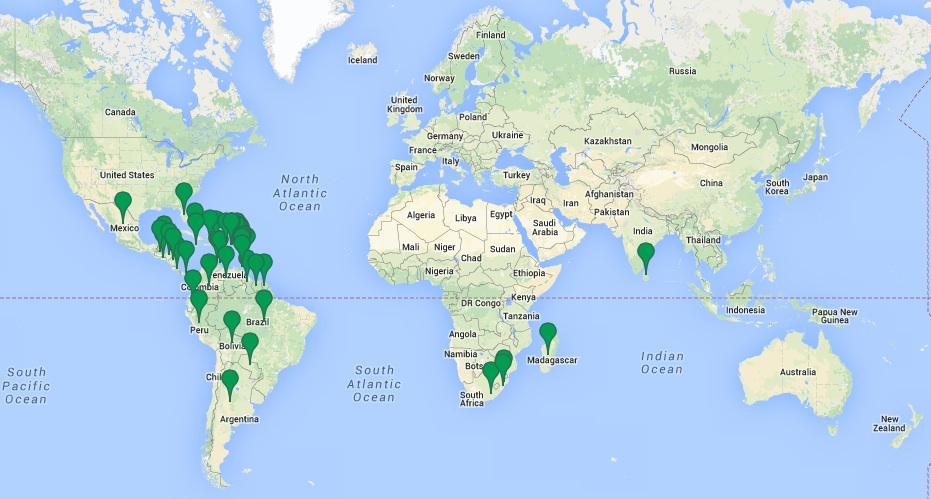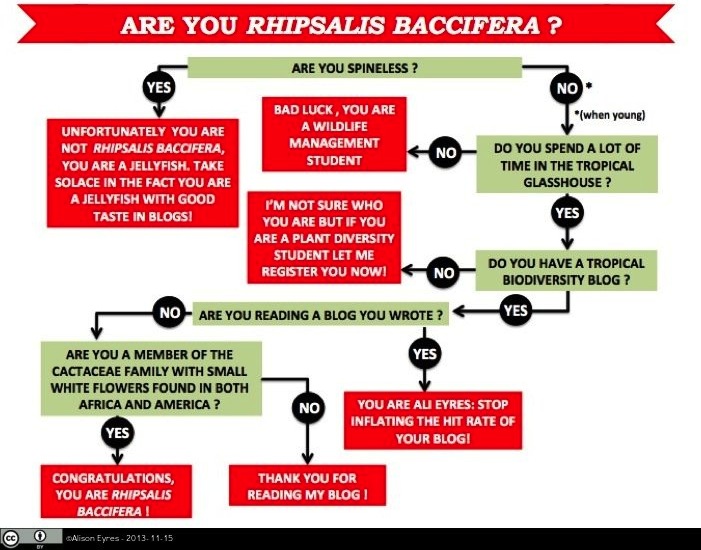“I Havana clue how I got here”
Were you hooked by the headline? Ok, so I was Havana bit of a laugh but there is some scientific basis in the story (albeit tenuous). Rhipsalis baccifera has a very interesting and puzzling distribution being the only cactus species that is found naturally outside of the Americas[1].
Although the cactus puns have been described as succulent by some [2] now I’ve got your attention I will stop and get on with the serious question of how this distribution arose…
Distribution pattern
R. baccifera has a wide native distribution and is found in tropical America, South America, Florida and Sri Lanka. It is also found in tropical Africa, Madagascar and as far south as South Africa [3]. Figure 1 shows this disjunct distribution with members of the same species being found spread across continents separated by at least 2600km of ocean [4]. The mystery of how plant species come to be distributed across continents has puzzled the finest minds for centuries (see below).

Figure 1. Native distribution of R. baccifera. Map based on IUCN Red List data. Click here for interactive map. Map data © 2014 Google, INEGI. Map. Google Maps. 23 Jan. 2014
There are 2 main biogeographical theories that seek to explain the fragmented distribution of taxa of the kind observed in R. baccifera: dispersal and vicariance:
|
Dispersal: The plants move |
Vicariance: The earth moves[5] |
|
This theory holds that some disjunct |
By this theory the distribution of a
|
An unsolved mystery
The vicariance theory suggests that R. baccifera arose before the supercontinent Gondwana began to break up (or at least before Africa and America were separated by the amount of water that separates them today). Determining whether this explanation is plausible depends on knowing the timings of the breakup of Gondwana and the emergence of R. baccifera. Africa and America are thought to have begun to break up around 130 million years ago[6] and so for this theory correct then R. baccifera would need to have emerged before this time. There is no generally accepted consensus on when Rhipsalis emerged with estimates ranging from before the break-up of Gondwana[6] to after the separation[7].
The second theory is that migrating birds could be responsible for long distance dispersal of R. baccifera.
The fleshy fruits of R. baccifera are enjoyed by birds[8] and so seeds could have been moved to new countries via their guts. However, there are a number of unresolved issues which make this theory uncertain: no likely candidate bird has been identified[8], it relies on seeds remaining within the bird for a long time and finally it doesn’t adequately account for R. baccifera being the only cactus with this distribution.[6].
The final suggestion is that R. baccifera was moved from America to Africa by ships in the 16th century[8]. No sensible explanation exists to explain why this cactus alone was moved about by humans (it has been suggested that lonely sailors took it on board as a replacement for Mistletoe!)[6] As R. baccifera is distributed widely, far from ports this theory is largely doubted[6]. However, it is possible that the initial dispersal was carried out by humans with further dispersal within Africa being carried out by birds[8].
Taxonomy and Classification
R. baccifera belongs in the Cactaceae family[3], a large complicated family that has undergone a great deal of taxonomic rearrangement[9]. Recent molecular and morphological data suggest that the tribe Anacampseroteae is the sister group of the Cactaceae[10]. However, other relations still remain unresolved.
Resolving the phylogeny of the Cactaceae and its sister groups is important as it will help us understand the evolution of key traits such as the origin of succulence. Within the Cactaceae, R. baccifera is placed in the genus Rhipsalis. Having 35 species, this is the largest genus of epiphytic cacti[11].
Morphology and characteristics of R. baccifera
This blog does not agree with the objectification of cacti (or any other plants). No cactus should be judged solely on their morphology. Beauty is more than epidermis and a thick waxy cuticle deep. As such this blog is supporting the “No more Page 3” campaign and the “Page 3 Cactus” that used to appear in this publication will no longer appear. It is demeaning and archaic and has no place in today’s society. Please try our fun quiz instead.
But how can we identify Rhipsalis baccifera?
Like most cacti R. baccifera has succulent stems, however in R. baccifera these are slender and narrow. Instead of the large permanent spines that are found in most cacti R. baccifera has tiny bristly spine-like structures, located within dispersed areoles. These bristly spines tend to disappear as the plant gets older[12].
Like most Rhipsalis, R. baccifera is an epiphyte and has pendulous branches that hang down from trees. The flowers are small (less than 1cm), actinomorphic and white[13]. The fruits are fleshy and contain many seeds.
A great deal of morphological variation exists within the species as a result of the existence of lots of geographically isolated populations. These different populations are accepted as sub-species. For more information on differentiating the sub-species of R. baccifera, click here.
Nomenclature
Owing to its white berries and long thin stems R. baccifera is also known by the common names Mistletoe Cactus and Spaghetti Cactus[14], respectively. However, in addition to these common names it has a lot of other scientific names (synonyms). Naming confusions arising from 3 main sources are the cause of the large number of synonyms:
- The naming of species relies on the use of type specimens. For example, if a botanist wants to know if a specimen is R. baccifera they must compare it to a type specimen to which the name R. baccifera is attached. For cacti this is difficult as they do not dry and press easily to make good herbarium specimens[15].
- Cacti are popular with horticulturalists and enthusiasts. Problems arise when enthusiasts don’t name species according to the rules of biological nomenclature[15].
- The morphological variation that exists within the species will have had a role in naming confusion.
Despite the huge variety of names that exist for Rhipsalis baccifera, as William Shakespeare might have written, “ A (young) Rhipsalis baccifera by any other name would (probably) still hurt if you sat on it”.
Uses
 R. baccifera is a popular plant with horticulturalists and enthusiasts. In addition, researchers have been investigating its potential medical uses and have shown that it exhibits inhibitory activity towards the causal agent of the STI Trichomonas vaginalis [16](right).
R. baccifera is a popular plant with horticulturalists and enthusiasts. In addition, researchers have been investigating its potential medical uses and have shown that it exhibits inhibitory activity towards the causal agent of the STI Trichomonas vaginalis [16](right).
Finally if it is the case that R. baccifera was spread to Africa by ships then I would wonder why sailors carried this particular cactus with them on the long journeys? Did they use them to decorate their cabins? Did they eat the berries? Perhaps as it lacks the hard spines of other cacti it was a popular choice for sailors to cuddle at night? Or maybe sailors in the 16th century were years ahead of us in the treatment of T. vaginalis?
Useful, ornamental and mysterious…the curious incident of the cactus found on 3 continents remains unsolved. It sounds like a case for Sherlock Holmes (just leave him alone for 50 minutes to think it over).
Quiz
Acknowledgements
This blog was largely influenced by ‘The Bird Sheet’ the official publication of the Pembroke Ornithology Society (POS) and so thanks go to its editors Alastair Cockburn and Andy Haine.
Attributions
Images are by Ali Eyres and are licensed under a Creative Commons Attribution 3.0 Unported License, with the exception of the R. baccifera flower image which is by “Stickpen” and has no copyright restrictions. The distribution map was created using googlemaps and has been attributed. The “No more page 3” logo is from the “No more page 3” campaign and is freely available to use on blogs.
References
1. Rebman, J.P & Pinkava, D.J. (2001) Opuntia Cacti of North America: An Overview. The Florida Entomologist Vol. 84, No. 4: 474-483. Available online. [Accessed 5th January 2014]
3. IUCN, 2013. Rhipsalis baccifera (Mistletoe cactus). Available online. [Accessed 5th January 2014]
4. Bandoni de Oliveiera et al. (2009) Paleogeography of the South Atlantic: a route for primates and rodents into the New World? Available online. [Accessed on 21/12/13}
5.Hemingway, E. (1940) For Whom the Bell Tolls. Available online. [Accessed on 5th January 2014]
6.Maxwell, P (1999) The Rhipsalis Riddle. Available online. [Accessed on 11th January 2014]
7.Nobel, P.S. ed. (1992) Cacti: Biology and Uses. Available online. [Accessed on 11th January 2014]
8.Cota-Sánchez, J.H & Bomfim-Patrício, M.C. (2010) Seed morphology, polyploidy and the evolutionary history of the epiphytic cactus Rhipsalis baccifera (Cactaceae). PoliBotanica. Available online. [Accessed on 11th January 2014].
9.Nyffeler, R. & Eggli, U. (2010) A farewell to dated ideas and concepts: molecular phylogenetics and a revised suprageneric classification of the family Cactaceae. Schumannia. Available online. [Accessed on 23rd January 2014]
10.Nyffeler, R. (2007) The closest relatives of cacti: insights from phylogenetic analyses of chloroplast and mitochondrial sequences with special emphasis on relationships in the tribe Anacampseroteae. American Journal of Botany. Vol. 94, No. 1: 89-101. Available online. [Accessed on 23rd January 2014]
11. Wikipedia, 2013. Rhipsalis. [online] Available online. [Accessed on 23rd January 2014]
12.Plant of the week, 2006. Rhipsalis baccifera-Mistletoe cactus-Cactaceae. Available online. [Accessed 0n 23rd January 2014]
13.Rhipsalis, 2012. Rhipsalis baccifera. Available online. [Accessed on 23rd January 2014]
14.Operation Wildflower, 2014. Operation Wildflower- rescuing indigenous vegetation- Category: climbers. Available online. [Accessed on 23rd January 2014]
15.Wikipedia, 2014. Cactus. Available online. [Accessed on 23rd January 2014]
16.Costa Brandelli, C.L., de Brum Vieira, P., José Macedo, A. & Tasca, T. (2o13) Remarkable Anti-Trichomonas vaginalis Activity of Plants Traditionally Used by the Mbyá-Guarani Indigenous Group in Brazil. BioMed Research International. Available online. [Accessed on 23rd January 2014]










Pingback: Inspiring the next generation of botanists! | Dr M Goes Wild
Pingback: Dr M on botanical creativity in science education | Dr M Goes Wild
Pingback: Dr M champions botanical creativity in science education | Dr M Goes Wild
Pingback: Advent Botany 2015 – Christmas Day: The Christmas Cactus | Culham Research Group
Pingback: The Mystery of the World's Least American Cactus – My small blog